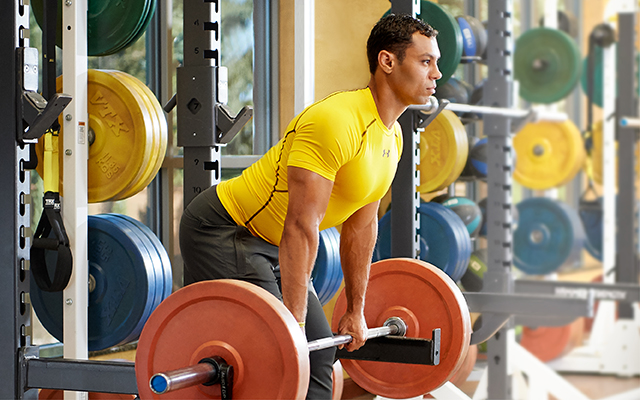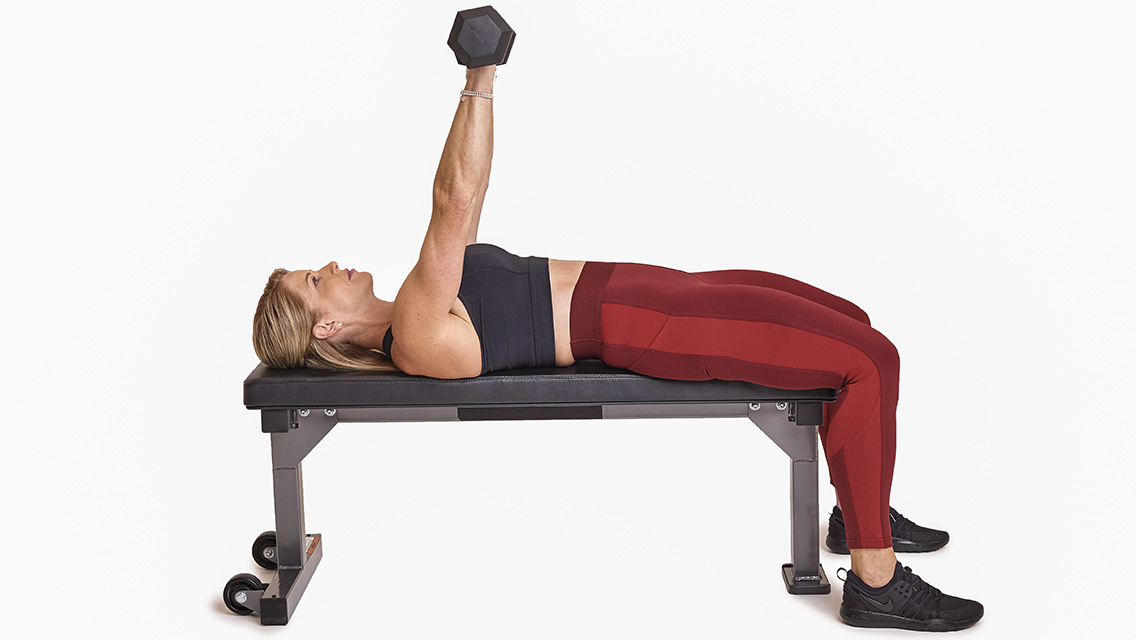A dumbbell complex leaves no room for stall tactics. Even circuit training — often hailed as the cardio king of the weight room — looks lazy in comparison.
That’s because a complex comprises two or more exercises strung together and performed as one continuous set. While a circuit might allow you to rest briefly between exercises (even if just to switch equipment), exercises in a complex all use the same pair of weights and are carefully ordered so that one movement flows immediately into the next.
Since you never stop moving during a complex, your heart rate remains elevated. This prompts greater cardiovascular benefits than you would get from a strength workout with rest periods, says Istvan “Steve” Javorek, the renowned strength-and-conditioning coach who developed the first dumbbell and barbell complexes in the 1960s.
Most complexes include multi-joint and compound exercises that require a significant amount of energy, such as moving from a squat to an overhead press. Performing these types of movements nonstop burns fat during the exercise and speeds up metabolism for hours afterward.
A complex can be designed to incorporate any type of equipment. For instance, a body-weight complex might include pushups, chin-ups, squat jumps, and lunges. Barbell complexes often include Olympic lifts, such as snatches, cleans, and jerks.
Javorek designed the following set using two dumbbells, which he considers among the most effective training tools in the gym. “Dumbbells allow for unlimited range of motion and stimulate your stabilizer muscles,” says Javorek — two benefits that can’t be achieved on a machine.
He encourages novice lifters not to be afraid of these ubiquitous weights. “There are no dangerous exercises, just dangerous techniques,” he says. “It’s very important that, with all dumbbell exercises, you start with light weights and learn the proper technique, and never hurry.” If you’re new to using free weights or unsure about form, seek out a coach or trainer for instruction.
Ready to get started? Watch this video and then try the routine, which is ideal for everyone from beginners to elite athletes.
Before You Lift
This dumbbell complex consists of six consecutive exercises, all performed with the same pair of weights. To prepare for it and determine the appropriate amount of weight to lift, follow these steps:
1) Learn the exercises. Practice each exercise individually with light weights until you can execute it with perfect form. Then, memorize the exercises and their order in the complex.
2) Test for your five-rep max. Perform a warm-up set for each individual exercise to determine your five-rep max (5RM), the weight at which you can perform five repetitions but no more, for each movement.
3) Calculate the appropriate weight. Now identify the weight of the dumbbells you used in the most challenging exercise in Step 2 (when you were determining your 5RM). The most challenging exercise will be the one in which you used the lightest weight. Once you have that number, plug it into the following formula to determine your load (weight of dumbbells) for the complex.
(5RM + 5) x (0.3) = Load
For example: Your lowest 5RM was for Bent-Over Triceps Extensions, which you performed with 15-lb. dumbbells.
(15 lbs. + 5) x (0.3) = 6 lbs.
Therefore, you will perform the entire complex with 6-lb. dumbbells (or 5-lb., if 6-lb. dumbbells are unavailable). The calculated weight might seem deceptively light, but because this is a workout performed without rest, be assured it won’t feel light by the end of one full complex.
Complex Protocol
- Perform 10 reps of each exercise in the order shown, without stopping between exercises.
- Keep your core muscles engaged during each exercise.
- After you’ve completed one set of the complex, actively rest for three to five minutes to keep your heart rate elevated. You can walk, jog, perform abdominal exercises, do light calisthenics, or practice dynamic stretching.
- Repeat the entire complex two to six times. For a greater challenge, gradually increase the load.
- You can perform this workout three times per week, allowing at least one day of recovery between workouts.
The Workout
1. Alternate Forward Leg Lunges
Full Instructions
- Standing with your feet at hip width, hold a dumbbell in each hand with arms at your sides and palms facing inward.
- Step your right foot forward about an arm’s length, landing first on your heel, then letting the rest of your foot roll to a flat position on the floor. Simultaneously bend your knees until your left knee is just barely above the ground and your lower left leg and right thigh are parallel to the ground. Your right knee should track inline with your middle toe and not cross over your toes. Be careful not to round your shoulders. (For more on proper lunging technique, see “Lunge With Confidence”.)
- Push off with your right heel to extend your right leg and bring your right foot back to the starting position.
- Repeat on the left side.
2. Parallel Curls and Continual Overhead Press
Full Instructions
- Standing with your feet at hip width, hold a dumbbell in each hand with arms at your sides and palms facing inward.
- Keeping your elbows at your sides, bend at your elbows to curl the weights up to shoulder height.
- Bend your knees slightly and then immediately press the weights upward, fully extending your arms. Your palms should continue to face inward. As you press the weights overhead, rise onto your toes.
- Lower the weights to shoulder height, bringing your elbows back to your sides and lowering your heels to the floor.
- Reverse the curling motion by lowering the dumbbells to their starting position.
3. Squat to Up-on-Toes Upright Rows
Perform 10 reps.
Full Instructions
- Standing with your feet at hip width, hold a dumbbell in each hand directly in front of your thighs.
- Keeping your body weight in your heels, push your hips backward and bend your knees to lower into a squat. Keep your torso as upright as possible.
- Stand and lift your elbows to raise the dumbbells to neck level, keeping the weights as close to your body as possible. Your elbows should drive the motion and should be higher than your forearms at the top position. As you pull the dumbbells upward, rise onto your toes.
- Slowly lower the dumbbells down to their starting position while returning your heels to the floor.
4. Bent-Over Triceps Extensions
Perform 10 reps.
Full Instructions
- Standing with your feet at hip width, hold a dumbbell in each hand at your side and your palms facing inward. With your knees slightly bent, push your hips back and bend over, keeping your back flat and almost parallel to the floor.
- Bring your elbows to the sides of your torso, so that your upper arms are parallel to the floor and as close to your body as possible, and your forearms are pointing down toward the floor.
- Without moving your elbows, use your triceps to straighten your arms and bring your forearms parallel to the floor.
- Keeping your elbows still, slowly curl the weights back in toward the armpits.
5. Up-on-Toes Squat Push Press
Perform 10 reps.
Full Instructions
- Stand holding a dumbbell in each hand, slightly in front of your chest at shoulder height, with your elbows by your sides and palms facing forward.
- Keeping your body weight in your heels, push your hips backward and bend your knees to lower into a squat. Keep your torso as upright as possible and do not allow the dumbbells to move from their initial position.
- Extend your legs to rise from the squat and immediately press the dumbbells overhead with an explosive motion, coming up on your toes. At the top of the movement, your arms should be fully extended and the dumbbells should be directly over your shoulders.
- Then lower into a squat as you return the weights to their starting position at shoulder height.
6. Quarter-Squat Jump With Raise to Armpit
Perform 10 reps.
Full Instructions
- Standing with your feet at hip width, hold a dumbbell in each hand at your side with your palms facing inward.
- Slightly push your hips back and bend your knees, lowering to about a quarter of a squat. Your body weight should be between the balls of your feet and your heels. Keep your torso as upright as possible.
- Push off the balls of your feet to perform a short jump. At the same time, pull the dumbbells toward your armpits. Your elbows should point backward and your palms should face the sides of your body throughout the movement.
- Softly land on the balls of your feet in the quarter-squat position, lowering the weights to your sides as you land.
⊕ After you’ve completed one set, actively rest for three to five minutes to keep your heart rate elevated.
⊗ Repeat the entire complex two to six times.
This article has been updated. It originally appeared as “The Smart Dumbbell Complex” in the January/February 2014 issue of Experience Life.




This Post Has 0 Comments